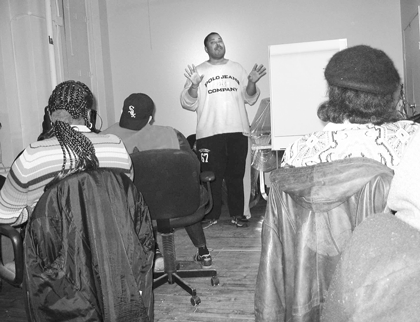Black gay prevention panel offers sobering insights
A town meeting concerning the state of HIV prevention among African-American gay men drew roughly 50 people to the Fashion Institute of Technology.
“To say that we have a lot of work to do is an understatement of monstrous proportions,” said Mark J. McLaurin, a panelist at the November 14 event and director of federal affairs at the New York AIDS Coalition, a group that represents AIDS organizations across the state.
The town meeting came after a study, published in June in the Morbidity and Mortality Weekly, a publication of the federal Centers for Disease Control and Prevention (CDC), reported that in a five-city study of 1,767 gay or bisexual men, 46 percent of the black men were HIV-positive. Twenty-one percent of the white men and 17 percent of the Latino men in that study were infected with the virus that causes AIDS.
After noting other earlier studies that have also found a higher HIV prevalence among black gay men than among their white or Latino peers, McLaurin said, “Not only do we have a lot of work to do, but some of us must face the fact that much of what we have done has not been effective… We must demand more of ourselves as leaders and I include myself in that category.”
Other panelists were more cautious about the recent statistic. Dr. Darrell P. Wheeler, a professor at the Hunter College School of Social Work, called it a “snapshot” that did not provide the “contextual experience” of these men’s lives. The sample was also limited, he said.
“This number is based on a sample of fewer than 2,000 men,” Wheeler said.
Wheeler is a principal investigator on Brothers y Hermanos, a CDC-funded study that will recruit 2,000 black and Latino gay men in four U.S. cities to explore, in part, that “contextual experience.”
While black and Latino men are included in studies of all gay men, there is little research that investigates just gay and bisexual men of color. Wheeler said that when his work on Brothers y Hermanos is complete, it will represent “50 percent of all national data” on black men who have sex with men.
“We have no clue, at this late date in the epidemic, what drives black gay men to stay safe,” Wheeler said.
The evening also included some discussion about town meetings that questioned whether they are effective.
Frank L. Roberts, a panelist who was described in the program as 23 and “one of the leading figures of the newest generation of black public intellectuals,” said, “The audience starts to look like my phonebook. These are not necessarily the men I will see at the club on Friday night.”
Another theme that ran throughout the evening was a discussion of the dollars spent to battle HIV among black gay men.
“There’s been a lot of conversation, since the statistics hit, about the allocation of resources,” said Kwame M. Banks, a panelist who is HIV-positive and the founder of Safer + Saner, a safe sex effort that targets the leather community. “We have to embrace philanthropy as a community.”
McLaurin said that one reason that people do not give to some AIDS groups is they are not confident about how the money will be spent.
“A lot of the philanthropy doesn’t occur because we don’t want to give money to dysfunctional organizations headed by dysfunctional leaders,” he said.
The town meeting was sponsored by Gay Men of African Descent, People of Color in Crisis, a Brooklyn-based AIDS group, and the New York State Black Gay Network, a group of organizations across New York that serve black gay men. The panel was moderated by Keith Boykin, author of “Beyond the Down Low: Sex, Lies, and Denial in Black America.”
gaycitynews.com



































